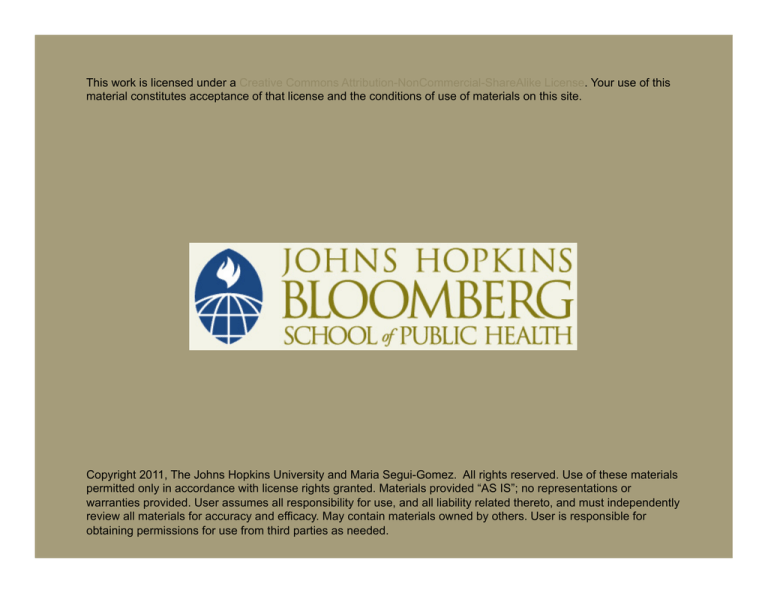
This work is licensed under a Creative Commons Attribution-NonCommercial-ShareAlike License. Your use of this
material constitutes acceptance of that license and the conditions of use of materials on this site.
Copyright 2011, The Johns Hopkins University and Maria Segui-Gomez. All rights reserved. Use of these materials
permitted only in accordance with license rights granted. Materials provided “AS IS”; no representations or
warranties provided. User assumes all responsibility for use, and all liability related thereto, and must independently
review all materials for accuracy and efficacy. May contain materials owned by others. User is responsible for
obtaining permissions for use from third parties as needed.
Section C
Evaluation Case Study
The Paper at Hand
Objective is to assess the impact of introducing or lowering
per se limits in Blood Alcohol Concentration (BAC) levels in
reducing motor vehicle–related injuries
Literature review of large number of papers published
up to 2000
Information on numerators (outcomes), denominators
(exposure), confounders (if any), study designs, analysis, and
results
Source: Mann et al. (2001). Acc Anal Prev, 1, 33, 569–583.
3
Goal of This Case Study Is to Emphasize the Need To:
Investigate the reported evidence on a particular injury
prevention intervention
Methodically go through the following steps:
- Understand what intervention is under evaluation
- Understand the choices of numerators
- Understand the choices of denominators
- Understand the choices of analysis
- Understand the underlying study designs
4
What Intervention(s)?
Define the intervention under evaluation (target population,
nature of the intervention, degree of divulgation,
enforcement [if any], etc.)
- Too often this is not properly explained, which makes
comparisons across “similar” interventions difficult
5
Analyzing the Evidence: Choices of Numerators
Events
- Of different severity
Injured individuals
- With different severities
Injuries
- Of different severity
Source: Cummings et al. (1995). Ann Rev Public Health, 16, 381–400.
6
Analyzing the Evidence: Choices of Numerators
Type of numerator
- Only one (e.g., nighttime fatal collisions)
- Several—do several analyses (e.g., nighttime fatal
collisions and proportion of intoxicated fatally injured
drivers)
- Several—integrate in an “index” (although no such
measure was used in the review under evaluation)
7
What Would Work Best?
Direct measure
- Roadside surveys of BAC levels
- Collisions with drivers with BAC higher than limit
More appropriate
Less appropriate
8
What Would Work Best?
Direct measure
- Roadside surveys of BAC levels
- Collisions with drivers with BAC higher than limit
Indirect or “proxy” measures
More appropriate
- BAC levels among fatal drivers
- Fatal drivers
- Nighttime fatal crashes, weekend
fatal collisions
Less appropriate
9
Analyzing the Evidence: Choices of Denominators
Exposure
- Alcohol consumption (more or less?)
- Time between drinking and driving (more or less?)
Confounders
- Total amount of driving (more or less?)
- Total amount of drivers
- Other safety measures (e.g., safety belt)
10
What Would Work Best?
Population of reference
That affected by population
Some generic or undifferentiated
population
More appropriate
Less appropriate
11
What Would Work Best?
Co-variates included:
- Control by changes in host, agent, and environmentrelated factors and/or changes in pre-event/event/postevent
Changes in risk of crash
More appropriate
Changes in risk of injury and or
more severe injuries (e.g., safety
belt)
Changes in risk of sequelae (e.g.,
EMS, acute care)
- Nothing
Less appropriate
12
Analyzing the Evidence: Study Designs
Simple pre- and post-comparisons
Pre-post comparisons with external control
Pre- and post-comparisons controlling for confounders and
external controls
What do we define as “post”
- Length of follow-up
13
What Would Work Best?
Follow-up time
- Long
- Short, e.g., right after intervention
More appropriate
Less appropriate
14
What Would Work Best?
Analysis level
Individual level
Population level (ecological)
More appropriate
Less appropriate
15
What Would Work Best?
Study design
(Same subject all interventions)
Experimental
Quasi-experimental
Cohort
Case control
Cross-sectional
Case series
Case report
More appropriate
Less appropriate
16
Analyzing the Evidence: Analytical Choices
Frequency (or proportions) of cases
Statistical comparisons of proportions
Statistical comparisons of proportions while controlling for
confounders
Statistical comparisons of more than two proportions (e.g.,
time series)
17
In This Particular Review
Pre-post comparisons
Time series analysis
Weighted least squares regression analysis (suggest control
by confounders, but how many, how well?)
Need to understand what researchers did
18
Evaluating Injury Prevention Interventions
No different than any other evaluation (need good
epidemiology and biostatistics!)
Take particular care on how to identify/count numerator:
- Including how to deal with multiple injuries/multiple
events
- How to identify denominator and/or exposure
19
Evaluating Injury Prevention Interventions
Take particular care on how to define intervention:
- Including the fact that many injury interventions are
“bundled” together
- And how to handle the repetitive nature of some
interventions (e.g., use of helmet every time one rides)
How to handle the length of time needed to judge the
intervention as effective
20
Putting It All Together
In the discussion:
- Look for realistic and objective statements based on
reported results
21
Discussion
“In most, but not all cases […], some beneficial effect on
traffic safety has been reported. These effects are in some
cases relatively small and in [others] temporary. Available
evidence suggests that where beneficial effects are observed
they are due to general deterrence and not limited only to
drivers with the BAC levels specifically affected by legal
change.”
22
For More Information on Systematic Reviews
American Journal of Preventive Medicine special issues
Cochrane Collaboration
23
The (Unfortunately Common) Reality on Evaluation
“First, we collect interventions. Everyone who has an idea can
call it a safety measure. Psychologists contribute educational
interventions and campaigning, lawyers enforcement
measures, engineers road construction, etc.”
Source: A good friend who wishes to remain anonymous.
24
The (Unfortunately Common) Reality on Evaluation
“Then, the number of fatalities and injuries that can be
prevented with these measures is being estimated (estimated
guesses are multiplied with four other estimated guesses,
which leads to well estimated guesses). Sometimes, we do it
the other way around: How many fatalities do we believe can
be prevented with this intervention? How large should be the
educated guess to come to the favored result? […]”
Source: A good friend who wishes to remain anonymous.
25
Program Selection
“And the costs are being (guess what) estimated . . .”
“This is about as far as we have come. I am looking forward to
what will happen next. I guess that one type of guess will be
divided by the other to conclude which measures have the
best cost-benefit ratio.”
Source: A good friend who wishes to remain anonymous.
26







